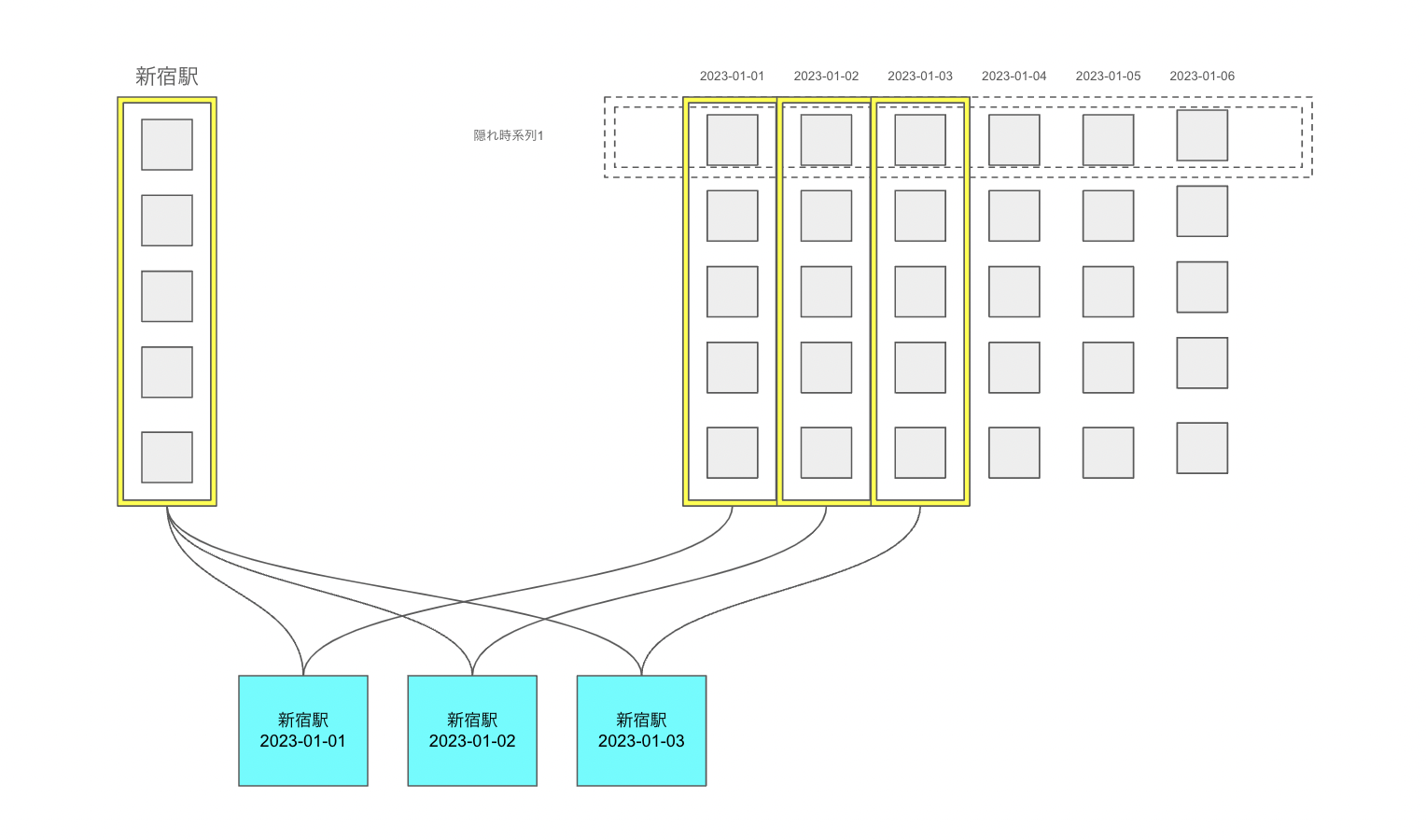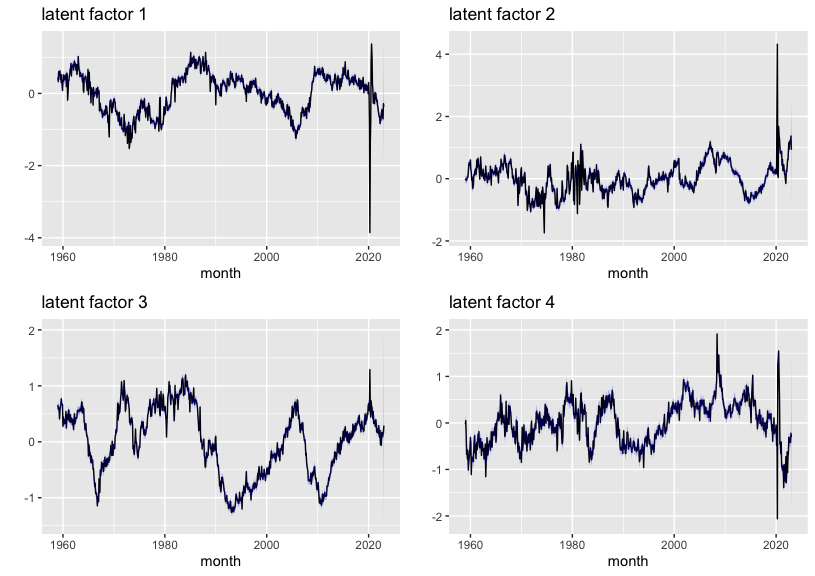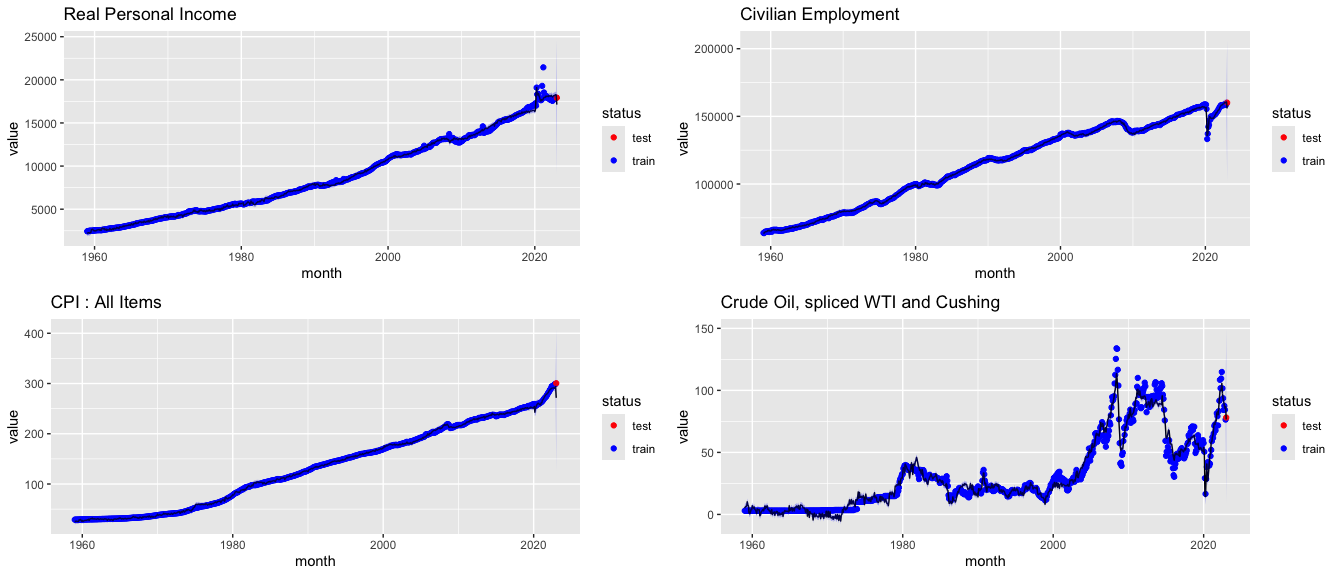はじめに
こんにちは、事業会社で働いているデータサイエンティストです。
本記事では、検証データに対して一部誤差率0.5%以下という高い精度を達成した多変量時系列モデル、ベイズファクターモデルを紹介します。
ファクターモデルとは
ファフターモデルは機械学習の世界で有名なembeddingモデル系と発想が極めて似ています。
まずembeddingモデルの代表のword2vecの復習から入りましょう。
word2vecの場合、対象の単語の埋め込み表現と周囲の文脈の単語の埋め込み表現の内積で対象の単語の出現を予測します。要するにこんな感じです
もちろん、活性化関数とか細かい内容もありますが、省略させてください。
ファフターモデルの場合、時系列の変数に埋め込み表現と時間の埋め込み表現がそれぞれ設定され、例えば鉄道駅の利用者数の時系列分析をする際、新宿駅の2024年4月1日の利用者数は
$$駅埋め込み表現_{新宿駅} '* 時間埋め込み表現_{2024年4月1日}$$
で表現されます。活性化関数などは省略します。
要するに、我々の手元にあるデータは、実はK個(埋め込み次元数)の見えない隠れ時系列の線形関係で表現できるということです。
図で表すと下記のようになります:
時系列分析問題をこのようにembedding系の手法に置き換えることで、大量の時系列の中に隠された相関とトレンドを効率よく学習することができ、高い予測性能が期待されます。
本記事が紹介する手法の理論的なところに興味ある方はBai and Wang(2015)をぜひ読んでみてください。
なお、本記事では、隠れ時系列、時間の埋め込み、ファクターを同義語として使います。
提案手法の紹介
時系列変数の埋め込み
時系列の埋め込みに関しては、仮説として、一部ノイズが強く、あまり質の良い情報を引き出せない変数もあります。なので、本手法は、馬蹄分布を事前分布として設定し、説明力の弱い変数の埋め込み表現が0付近になるようにします。
時間の埋め込み
時間の埋め込みに関しては、ベクトル自己回帰のモデル構造を設定します。
観測できない隠れ時系列に計量マクロ経済学でお馴染みのベクトル自己回帰を設定するだけです。
さらに、過去のXヶ月前の情報の重要度は埋め込み次元によって変わらないという情報を、馬蹄分布で表します。
例えば、ビジネスの場合、よく昨対比(さくたいひ)という表現を使いますが、これは要するに12ヶ月前のデータが今月のデータの状況をよく表すという事前情報です。
モデルの定式化
少し数学的な表現になりますが、本記事で提案するモデルはこのように定式化できます:
- 全体
$$sigma\sim Gamma(5, 5)$$
- 時系列変数
$$tau\space lambda\sim Cauchy(0, 1)$$
全ての時系列変数iについて
$$rho\space lambda_{i}\sim Cauchy(0, 1)$$
$$lambda_{i}\sim Normal(0, tau\space lambda * rho\space lambda_{i})$$
- 時間
$$tau\space lag\sim Cauchy(0, 1)$$
全てのラグ数iについて
$$rho\space lag_{i}\sim Cauchy(0, 1)$$
$$A_{i}\sim Normal(0, tau\space lag * rho\space lag_{i})$$
iを1から最大の時間まで
$$F_{i}\sim Normal(A_{1} * F_{i - 1} + A_{2} * F_{i - 2} + ... + A_{最大ラグ数} * F_{i - 最大ラグ数}, 1)$$
- 観測値
全ての観測値iについて
$$value_{i}\sim Normal(lambda_{時系列変数_{i}} '* F_{時間_{i}}, 1/sigma)$$
モデル実装
Stanでの実装はこんな感じです:
functions {
real partial_sum_lpdf(
array[] real value,
int start, int end,
array[] int series, array[] int time,
real sigma,
matrix F, matrix lambda
){
vector[end - start + 1] log_likelihood;
int count = 1;
for (i in start:end){
log_likelihood[count] = normal_lupdf(value[count] | F[time[i],] * lambda[series[i],]', 1/sigma);
count += 1;
}
return sum(log_likelihood);
}
}
data {
int series_type;
int time_type;
int lag;
int K;
int N;
array[N] int series;
array[N] int time;
array[N] real value;
int N_full;
array[N_full] int series_full;
array[N_full] int time_full;
vector[N_full] value_mean;
vector[N_full] value_sd;
}
parameters {
real<lower=0> sigma;
matrix[time_type, K] F;
real<lower=0> tau_lambda;
vector<lower=0>[series_type] rho_lambda;
matrix[series_type, K] lambda;
real<lower=0> tau_lag;
vector<lower=0>[lag] rho_lag;
array[lag] matrix[K, K] A;
}
model {
sigma ~ gamma(5, 5);
tau_lambda ~ cauchy(0, 1);
rho_lambda ~ cauchy(0, 1);
tau_lag ~ cauchy(0, 1);
rho_lag ~ cauchy(0, 1);
for (i in 1:series_type){
to_vector(lambda[i,]) ~ normal(0, tau_lambda * rho_lambda[i]);
}
for (i in 1:lag){
to_vector(A[i]) ~ normal(0, tau_lag * rho_lag[i]);
}
to_vector(F[1:lag,]) ~ normal(0, 1);
for (i in (lag + 1):time_type){
row_vector[K] this_F = rep_vector(0.0, K)';
for (j in 1:lag){
this_F += F[i - j] * A[j];
}
F[i,] ~ normal(this_F, 1);
}
int grainsize = 1;
target += reduce_sum(
partial_sum_lupdf, value, grainsize,
series, time,
sigma,
F, lambda
);
}
generated quantities {
vector[N_full] value_predicted;
for (i in 1:N_full){
value_predicted[i] = normal_rng((F[time_full[i],] * lambda[series_full[i],]' * value_sd[i]) + value_mean[i], 1/sigma);
}
}
前処理
本記事では、アメリカのマクロ経済に関連する大量の時系列データを利用します。
> data(fred_md, package = "BVAR")
> fred_md |>
tibble::rownames_to_column(var = "month") |>
tibble::tibble()
# A tibble: 769 × 119
month RPI W875RX1 DPCERA3M086SBEA CMRMTSPLx RETAILx INDPRO IPFPNSS IPFINAL IPCONGD IPDCONGD IPNCONGD IPBUSEQ IPMAT IPDMAT IPNMAT IPMANSICS IPB51222S IPFUELS CUMFNS HWI HWIURATIO
<chr> <dbl> <dbl> <dbl> <dbl> <dbl> <dbl> <dbl> <dbl> <dbl> <dbl> <dbl> <dbl> <dbl> <dbl> <dbl> <dbl> <dbl> <dbl> <dbl> <int> <dbl>
1 1959-01… 2442. 2293. 17.3 292266. 18236. 22.0 23.4 22.3 31.6 18.7 38.2 8.15 20.1 12.1 30.7 20.9 19.9 34.7 80.2 1357 0.334
2 1959-02… 2452. 2302. 17.5 294425. 18370. 22.4 23.7 22.5 31.8 18.8 38.5 8.26 20.8 12.7 31.2 21.3 19.9 34.2 81.4 1421 0.358
3 1959-03… 2468. 2318. 17.6 293419. 18523. 22.8 23.9 22.6 31.8 19.2 38.3 8.35 21.3 13.2 31.7 21.6 20.0 35.1 82.5 1524 0.401
4 1959-04… 2484. 2335. 17.6 299323. 18534. 23.3 24.2 22.9 32.3 19.3 39.0 8.56 21.9 13.6 32.6 22.1 20.1 34.9 84.0 1589 0.445
5 1959-05… 2498. 2350. 17.8 301364. 18680. 23.6 24.4 23.1 32.5 19.7 39.0 8.84 22.5 14.1 32.9 22.4 20.4 34.2 84.9 1655 0.476
6 1959-06… 2506. 2357. 17.8 301349. 18850. 23.6 24.6 23.3 32.3 19.8 38.7 9.05 22.3 14.0 32.8 22.4 20.5 34.2 84.8 1717 0.501
7 1959-07… 2504. 2356. 17.8 305020. 18844. 23.1 24.6 23.5 32.7 20.2 39.0 9.07 21.0 12.6 33.0 22.0 20.8 33.5 83.0 1723 0.488
8 1959-08… 2490. 2342. 17.9 289435. 18964. 22.3 24.4 23.4 32.8 19.6 39.5 8.99 19.4 11.0 32.9 21.1 20.9 34.0 79.5 1638 0.457
9 1959-09… 2492. 2342. 18.1 293698. 18716. 22.3 24.3 23.4 32.7 19.1 39.7 8.92 19.4 11.0 32.9 21.1 21.3 33.8 79.0 1605 0.425
10 1959-10… 2495. 2345. 17.9 294168. 18853. 22.1 24.3 23.3 32.5 19.5 39.2 8.85 19.2 10.8 32.3 20.9 21.4 33.6 78.2 1553 0.397
# ℹ 759 more rows
# ℹ 97 more variables: CLF16OV <int>, CE16OV <int>, UNRATE <dbl>, UEMPMEAN <dbl>, UEMPLT5 <int>, UEMP5TO14 <int>, UEMP15OV <int>, UEMP15T26 <int>, UEMP27OV <int>, CLAIMSx <int>,
# PAYEMS <int>, USGOOD <int>, CES1021000001 <dbl>, USCONS <int>, MANEMP <int>, DMANEMP <int>, NDMANEMP <int>, SRVPRD <int>, USTPU <int>, USWTRADE <dbl>, USTRADE <dbl>, USFIRE <int>,
# USGOVT <int>, CES0600000007 <dbl>, AWOTMAN <dbl>, AWHMAN <dbl>, HOUST <int>, HOUSTNE <int>, HOUSTMW <int>, HOUSTS <int>, HOUSTW <int>, PERMIT <int>, PERMITNE <int>, PERMITMW <int>,
# PERMITS <int>, PERMITW <int>, ACOGNO <int>, AMDMNOx <dbl>, ANDENOx <dbl>, AMDMUOx <dbl>, BUSINVx <dbl>, ISRATIOx <dbl>, M1SL <dbl>, M2SL <dbl>, M2REAL <dbl>, BOGMBASE <int>,
# TOTRESNS <dbl>, NONBORRES <int>, BUSLOANS <dbl>, REALLN <dbl>, NONREVSL <dbl>, CONSPI <dbl>, FEDFUNDS <dbl>, CP3Mx <dbl>, TB3MS <dbl>, TB6MS <dbl>, GS1 <dbl>, GS5 <dbl>, GS10 <dbl>,
# COMPAPFFx <dbl>, TB3SMFFM <dbl>, TB6SMFFM <dbl>, T1YFFM <dbl>, T5YFFM <dbl>, T10YFFM <dbl>, AAAFFM <dbl>, EXSZUSx <dbl>, EXJPUSx <dbl>, EXUSUKx <dbl>, EXCAUSx <dbl>, …
# ℹ Use `print(n = ...)` to see more rows
変数はかなり多いため、具体的な定義は省略します。詳細に興味ある方は下記のリンクを確認してください。Read Full Textの中のPDFの最後のところに説明があります。
これだとデータ分析と可視化の作業がめんどくさくなるので、データベース形式に変形して、値を標準化します:
freq_df <- fred_md |>
tibble::rownames_to_column(var = "month") |>
tibble::tibble() |>
tidyr::pivot_longer(!month, names_to = "series", values_to = "value") |>
tidyr::drop_na() |>
dplyr::group_by(series) |>
dplyr::mutate(
value_std = (value - mean(value))/sd(value)
) |>
dplyr::ungroup()
処理の結果はこんな感じです:
> freq_df
# A tibble: 90,010 × 4
month series value value_std
<chr> <chr> <dbl> <dbl>
1 1959-01-01 RPI 2442. -1.39
2 1959-01-01 W875RX1 2293. -1.43
3 1959-01-01 DPCERA3M086SBEA 17.3 -1.37
4 1959-01-01 CMRMTSPLx 292266. -1.41
5 1959-01-01 RETAILx 18236. -1.10
6 1959-01-01 INDPRO 22.0 -1.68
7 1959-01-01 IPFPNSS 23.4 -1.76
8 1959-01-01 IPFINAL 22.3 -1.74
9 1959-01-01 IPCONGD 31.6 -2.00
10 1959-01-01 IPDCONGD 18.7 -1.63
# ℹ 90,000 more rows
# ℹ Use `print(n = ...)` to see more rows
次に、マスター表を作成して、元データに結合します:
month_master <- freq_df |>
dplyr::select(month) |>
dplyr::distinct() |>
dplyr::arrange(month) |>
dplyr::mutate(
month_id = dplyr::row_number()
)
series_master <- freq_df |>
dplyr::group_by(series) |>
dplyr::summarise(
# 標準化から元の状態に戻す処理もStanで実施するため、
# 元に戻すために必要な時系列の平均値と標準偏差も持たせます
value_mean = mean(value),
value_sd = sd(value)
) |>
dplyr::ungroup() |>
dplyr::mutate(
series_id = dplyr::row_number()
)
freq_df_with_id <- freq_df |>
dplyr::left_join(month_master, by = "month") |>
dplyr::left_join(series_master, by = "series")
最後に、2023年1月を検証期間、残りの期間を学習期間にして、Stanに入れるためのリストを作成します:
freq_df_with_id_train <- freq_df_with_id |>
dplyr::filter(as.Date(month) < as.Date("2023-01-01"))
fm_data_list <- list(
series_type = nrow(series_master),
time_type = nrow(month_master),
lag = 24,
K = 20,
N = nrow(freq_df_with_id_train),
series = freq_df_with_id_train$series_id,
time = freq_df_with_id_train$month_id,
value = freq_df_with_id_train$value_std,
N_full = nrow(freq_df_with_id),
series_full = freq_df_with_id$series_id,
time_full = freq_df_with_id$month_id,
value_mean = freq_df_with_id$value_mean,
value_sd = freq_df_with_id$value_sd
)
モデル推定
では早速モデル推定を実施しましょう:
m_fm_init <- cmdstanr::cmdstan_model("factor_model.stan",
cpp_options = list(
stan_threads = TRUE
)
)
> m_fm_estimate <- m_fm_init$variational(
seed = 123,
threads = 10,
iter = 10000,
data = fm_data_list
)
------------------------------------------------------------
EXPERIMENTAL ALGORITHM:
This procedure has not been thoroughly tested and may be unstable
or buggy. The interface is subject to change.
------------------------------------------------------------
Gradient evaluation took 0.082193 seconds
1000 transitions using 10 leapfrog steps per transition would take 821.93 seconds.
Adjust your expectations accordingly!
Begin eta adaptation.
Iteration: 1 / 250 [ 0%] (Adaptation)
Iteration: 50 / 250 [ 20%] (Adaptation)
Iteration: 100 / 250 [ 40%] (Adaptation)
Iteration: 150 / 250 [ 60%] (Adaptation)
Iteration: 200 / 250 [ 80%] (Adaptation)
Iteration: 250 / 250 [100%] (Adaptation)
Success! Found best value [eta = 0.1].
Begin stochastic gradient ascent.
iter ELBO delta_ELBO_mean delta_ELBO_med notes
100 -4193500.981 1.000 1.000
200 -866611.556 2.419 3.839
300 -292951.149 2.266 1.958
400 -199032.629 1.817 1.958
500 -167398.522 1.492 1.000
600 -144742.300 1.269 1.000
700 -127139.343 1.108 0.472
800 -113434.299 0.984 0.472
900 -103125.225 0.886 0.189
1000 -95362.491 0.806 0.189
1100 -88212.874 0.714 0.157 MAY BE DIVERGING... INSPECT ELBO
1200 -82386.567 0.337 0.138
1300 -76413.807 0.149 0.121
1400 -72058.758 0.108 0.100
1500 -66591.237 0.097 0.082
1600 -62144.785 0.088 0.081
1700 -57599.750 0.083 0.081
1800 -52933.312 0.079 0.081
1900 -48490.394 0.078 0.081
2000 -44534.775 0.079 0.081
2100 -40776.040 0.080 0.082
2200 -37388.445 0.082 0.088
2300 -33770.114 0.085 0.089
2400 -30575.935 0.090 0.091
2500 -27031.526 0.094 0.092
2600 -23366.836 0.103 0.092
2700 -20446.933 0.109 0.104
2800 -17089.746 0.120 0.107
2900 -13934.728 0.134 0.131
3000 -11375.317 0.147 0.143
3100 -8940.380 0.165 0.157
3200 -6417.406 0.196 0.196
3300 -4585.855 0.225 0.225
3400 -2782.622 0.279 0.226
3500 -1020.530 0.439 0.272
3600 532.426 0.715 0.393 MAY BE DIVERGING... INSPECT ELBO
3700 1740.786 0.770 0.399 MAY BE DIVERGING... INSPECT ELBO
3800 2918.501 0.791 0.404 MAY BE DIVERGING... INSPECT ELBO
3900 3949.189 0.794 0.404 MAY BE DIVERGING... INSPECT ELBO
4000 4789.023 0.789 0.404 MAY BE DIVERGING... INSPECT ELBO
4100 5733.633 0.778 0.404 MAY BE DIVERGING... INSPECT ELBO
4200 6584.464 0.752 0.404 MAY BE DIVERGING... INSPECT ELBO
4300 7376.616 0.723 0.404 MAY BE DIVERGING... INSPECT ELBO
4400 7888.857 0.664 0.261 MAY BE DIVERGING... INSPECT ELBO
4500 8559.027 0.500 0.175
4600 8926.323 0.212 0.165
4700 9592.507 0.150 0.129
4800 9957.054 0.113 0.107
4900 10332.796 0.090 0.078
5000 10702.690 0.076 0.069
5100 10974.992 0.062 0.065
5200 11339.882 0.053 0.041
5300 11757.824 0.045 0.037
5400 11829.328 0.040 0.036
5500 12302.325 0.036 0.036
5600 12462.006 0.033 0.036
5700 12864.882 0.029 0.035
5800 12858.217 0.025 0.032
5900 13197.644 0.024 0.031
6000 13357.017 0.022 0.026
6100 13477.003 0.020 0.026
6200 13767.390 0.019 0.021
6300 13808.533 0.016 0.013
6400 14055.295 0.017 0.018
6500 14145.486 0.014 0.013
6600 14386.733 0.014 0.017
6700 14642.994 0.013 0.017
6800 14622.294 0.013 0.017
6900 14951.490 0.013 0.017
7000 15028.594 0.012 0.017
7100 15165.693 0.012 0.017
7200 15386.309 0.011 0.014
7300 15449.487 0.011 0.014
7400 15491.187 0.010 0.009 MEAN ELBO CONVERGED MEDIAN ELBO CONVERGED
Drawing a sample of size 1000 from the approximate posterior...
COMPLETED.
Finished in 431.5 seconds.
問題なく収束しました!
最後に結果を保存します:
m_fm_summary <- m_fm_estimate$summary()
可視化
では、まずは学習された最初の四つの隠れ時系列を確認しましょう。
g_f1 <- m_fm_summary |>
dplyr::filter(stringr::str_detect(variable, "F")) |>
dplyr::mutate(
id = purrr::map(
variable,
\(x){
as.numeric(stringr::str_split(x, "\\[|\\]|,")[[1]][2:3])
}
)
) |>
tidyr::unnest_wider(id, names_sep = "_") |>
dplyr::filter(id_2 == 1) |>
ggplot2::ggplot() +
ggplot2::geom_line(ggplot2::aes(x = as.Date(month_master$month), y = mean)) +
ggplot2::geom_ribbon(ggplot2::aes(x = as.Date(month_master$month), ymin = q5, ymax = q95),
fill = ggplot2::alpha("blue", 0.3)) +
ggplot2::xlab("month") +
ggplot2::ylab("") +
ggplot2::ggtitle("latent factor 1")
g_f2 <- m_fm_summary |>
dplyr::filter(stringr::str_detect(variable, "F")) |>
dplyr::mutate(
id = purrr::map(
variable,
\(x){
as.numeric(stringr::str_split(x, "\\[|\\]|,")[[1]][2:3])
}
)
) |>
tidyr::unnest_wider(id, names_sep = "_") |>
dplyr::filter(id_2 == 2) |>
ggplot2::ggplot() +
ggplot2::geom_line(ggplot2::aes(x = as.Date(month_master$month), y = mean)) +
ggplot2::geom_ribbon(ggplot2::aes(x = as.Date(month_master$month), ymin = q5, ymax = q95),
fill = ggplot2::alpha("blue", 0.3)) +
ggplot2::xlab("month") +
ggplot2::ylab("") +
ggplot2::ggtitle("latent factor 2")
g_f3 <- m_fm_summary |>
dplyr::filter(stringr::str_detect(variable, "F")) |>
dplyr::mutate(
id = purrr::map(
variable,
\(x){
as.numeric(stringr::str_split(x, "\\[|\\]|,")[[1]][2:3])
}
)
) |>
tidyr::unnest_wider(id, names_sep = "_") |>
dplyr::filter(id_2 == 3) |>
ggplot2::ggplot() +
ggplot2::geom_line(ggplot2::aes(x = as.Date(month_master$month), y = mean)) +
ggplot2::geom_ribbon(ggplot2::aes(x = as.Date(month_master$month), ymin = q5, ymax = q95),
fill = ggplot2::alpha("blue", 0.3)) +
ggplot2::xlab("month") +
ggplot2::ylab("") +
ggplot2::ggtitle("latent factor 3")
g_f4 <- m_fm_summary |>
dplyr::filter(stringr::str_detect(variable, "F")) |>
dplyr::mutate(
id = purrr::map(
variable,
\(x){
as.numeric(stringr::str_split(x, "\\[|\\]|,")[[1]][2:3])
}
)
) |>
tidyr::unnest_wider(id, names_sep = "_") |>
dplyr::filter(id_2 == 4) |>
ggplot2::ggplot() +
ggplot2::geom_line(ggplot2::aes(x = as.Date(month_master$month), y = mean)) +
ggplot2::geom_ribbon(ggplot2::aes(x = as.Date(month_master$month), ymin = q5, ymax = q95),
fill = ggplot2::alpha("blue", 0.3)) +
ggplot2::xlab("month") +
ggplot2::ylab("") +
ggplot2::ggtitle("latent factor 4")
gridExtra::grid.arrange(g_f1, g_f2, g_f3, g_f4)
推定された隠れ時系列の細かい解釈は本記事の範囲外ですが、最初の四つの隠れ時系列はいずれもコロナ禍が始まった2020年1月当たりに急激な変化が見られたことを強調したいです。
続いては予測された時系列の全体の動きを確認しましょう。
ただ、変数が多いため、実質個人所得、民間雇用数、消費者物価指数、原油価格のみ可視化します。
全体の傾向を表していると言えそうです!
精度確認
最後に検証データに対する予測精度を確認します。
評価指標として誤差率
$$|正解 - 予測結果|/正解$$
を利用します。
> m_fm_summary |>
dplyr::filter(stringr::str_detect(variable, "value_predicted")) |>
dplyr::bind_cols(ans = freq_df_with_id |>
dplyr::select(month, series, value)
) |>
dplyr::mutate(
month = as.Date(month),
status = ifelse(month < as.Date("2023-01-01"), "train", "test"),
error_ratio = abs((value - mean)/value),
mean = round(mean, 2)
) |>
dplyr::filter(status == "test") |>
dplyr::select(series, value, mean, error_ratio) |>
print(n = 200)
# A tibble: 108 × 4
series value mean error_ratio
<chr> <dbl> <dbl> <dbl>
1 RPI 17921. 17125. 0.0444
2 W875RX1 14745 14069. 0.0459
3 DPCERA3M086SBEA 130. 121. 0.0689
4 RETAILx 696982 599553. 0.140
5 INDPRO 103. 100. 0.0264
6 IPFPNSS 103. 101. 0.0156
7 IPFINAL 104. 102. 0.0202
8 IPCONGD 103. 101. 0.0255
9 IPDCONGD 110. 105. 0.0533
10 IPNCONGD 101. 100. 0.0114
11 IPBUSEQ 96.9 95.6 0.0134
12 IPMAT 103. 99.7 0.0317
13 IPDMAT 96.2 94.3 0.0195
14 IPNMAT 96.2 96.4 0.00283
15 IPMANSICS 100. 98.5 0.0169
16 IPB51222S 98.4 105. 0.0651
17 IPFUELS 86.8 87.3 0.00568
18 CUMFNS 77.7 76.7 0.0138
19 CLF16OV 165832 161985. 0.0232
20 CE16OV 160138 155846. 0.0268
21 UNRATE 3.4 3.86 0.136
22 UEMPMEAN 20.4 19.9 0.0257
23 UEMPLT5 1946 2194. 0.127
24 UEMP5TO14 1785 2033. 0.139
25 UEMP15OV 2001 2046. 0.0223
26 UEMP15T26 890 855. 0.0397
27 UEMP27OV 1111 1187. 0.0688
28 CLAIMSx 191750 270658. 0.412
29 PAYEMS 155073 150270. 0.0310
30 USGOOD 21514 21601. 0.00403
31 CES1021000001 586. 635. 0.0841
32 USCONS 7884 7720. 0.0208
33 MANEMP 12999 13163. 0.0126
34 DMANEMP 8102 8272. 0.0210
35 NDMANEMP 4897 4903. 0.00131
36 SRVPRD 133559 128320. 0.0392
37 USTPU 28819 28166. 0.0226
38 USWTRADE 6041 5957. 0.0139
39 USTRADE 15483. 15460. 0.00147
40 USFIRE 9114 8885. 0.0251
41 USGOVT 22389 21990. 0.0178
42 CES0600000007 40.8 40.4 0.00908
43 AWOTMAN 3.8 3.72 0.0221
44 AWHMAN 40.9 40.8 0.00265
45 HOUST 1309 1365. 0.0425
46 HOUSTNE 119 131. 0.0991
47 HOUSTMW 123 180. 0.460
48 HOUSTS 760 736. 0.0315
49 HOUSTW 307 312. 0.0153
50 PERMIT 1339 1454. 0.0861
51 PERMITNE 106 132. 0.248
52 PERMITMW 178 184. 0.0351
53 PERMITS 762 807. 0.0587
54 PERMITW 293 332. 0.134
55 AMDMNOx 272257 248889. 0.0858
56 ANDENOx 83875 80376. 0.0417
57 AMDMUOx 1156999 1088231. 0.0594
58 M1SL 19641 14980. 0.237
59 M2SL 21267. 18552. 0.128
60 M2REAL 7076. 6656. 0.0594
61 BOGMBASE 5328400 4757822. 0.107
62 TOTRESNS 3030. 2770. 0.0858
63 NONBORRES 3014200 2734769. 0.0927
64 BUSLOANS 2837. 2491. 0.122
65 REALLN 5367. 4684 0.127
66 FEDFUNDS 4.33 3.62 0.165
67 CP3Mx 4.61 4.01 0.131
68 TB3MS 4.54 3.73 0.178
69 TB6MS 4.67 3.82 0.182
70 GS1 4.69 4.1 0.126
71 GS5 3.64 3.55 0.0237
72 GS10 3.53 3.47 0.0183
73 COMPAPFFx 0.28 0.37 0.323
74 TB3SMFFM 0.21 0.13 0.382
75 TB6SMFFM 0.34 0.26 0.221
76 T1YFFM 0.36 0.47 0.303
77 T5YFFM -0.69 0 1.00
78 T10YFFM -0.8 -0.14 0.820
79 AAAFFM 0.07 0.89 11.7
80 EXSZUSx 0.924 0.93 0.00689
81 EXJPUSx 130. 119 0.0877
82 EXUSUKx 1.22 1.37 0.116
83 EXCAUSx 1.34 1.33 0.0114
84 WPSFD49207 257. 228. 0.114
85 WPSFD49502 278. 244. 0.124
86 WPSID61 264. 236. 0.108
87 WPSID62 281. 257. 0.0846
88 OILPRICEx 78.1 76.6 0.0194
89 PPICMM 249. 242. 0.0303
90 CPIAUCSL 301. 271. 0.0967
91 CPIAPPSL 129. 125 0.0315
92 CPITRNSL 263. 238. 0.0971
93 CPIMEDSL 552. 511. 0.0740
94 CUSR0000SAC 223. 204. 0.0831
95 CUSR0000SAD 126. 121. 0.0406
96 CUSR0000SAS 377. 341. 0.0957
97 CPIULFSL 298. 271. 0.0902
98 CUSR0000SA0L2 277. 252. 0.0877
99 CUSR0000SA0L5 288. 261. 0.0940
100 PCEPI 126. 116. 0.0780
101 DDURRG3M086SBEA 96.9 97.6 0.00687
102 DNDGRG3M086SBEA 115. 106. 0.0754
103 DSERRG3M086SBEA 135. 123. 0.0906
104 CES0600000008 28.9 26.2 0.0945
105 CES2000000008 33.4 30 0.101
106 CES3000000008 25.8 23.5 0.0904
107 UMCSENTx 64.9 69.0 0.0629
108 INVEST 5515. 4762. 0.136
Moody’s Aaa Corporate Bond Minus FEDFUNDS(AAAFFM)のように大きく外れた変数もありますが、誤差率は全体的に低いです。All Employees: Nondurable goods(NDMANEMP)のように0.1%を達成した変数もあります。
全体の誤差率の平均も20%で、かなり信用できるモデルを構築できたのではないかと思います。
> m_fm_summary |>
dplyr::filter(stringr::str_detect(variable, "value_predicted")) |>
dplyr::bind_cols(ans = freq_df_with_id |>
dplyr::select(month, series, value)
) |>
dplyr::mutate(
month = as.Date(month),
status = ifelse(month < as.Date("2023-01-01"), "train", "test"),
error_ratio = abs((value - mean)/value),
mean = round(mean, 2)
) |>
dplyr::filter(status == "test") |>
dplyr::pull(error_ratio) |>
mean()
[1] 0.2052737959
結論
いかがでしたか?
ファクターモデルは高い予測性能を達成できるだけでなく、隠れ時系列に対する考察から手元のデータに対してより深い理解を得ることができます。
また、因果推論においては、欠損する処置状態のデータを補完するためにも利用できます。
興味ある方はBai and Ng(2021)を読んでみてください。
皆さんもぜひファクターモデルをご自身のデータ分析で活用してください!
参考資料
Bai, Jushan, and Serena Ng. "Matrix completion, counterfactuals, and factor analysis of missing data." Journal of the American Statistical Association 116.536 (2021): 1746-1763.
Bai, Jushan, and Peng Wang. "Identification and Bayesian estimation of dynamic factor models." Journal of Business & Economic Statistics 33.2 (2015): 221-240.


